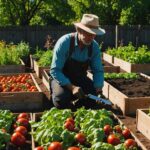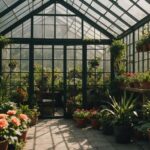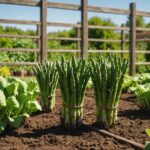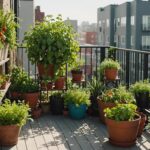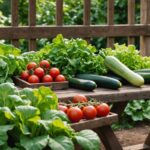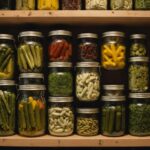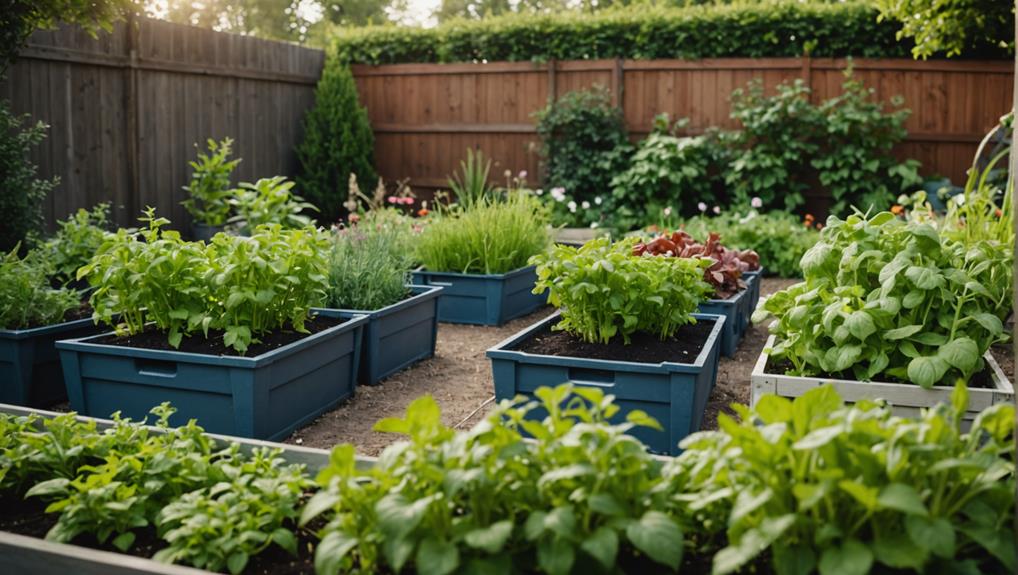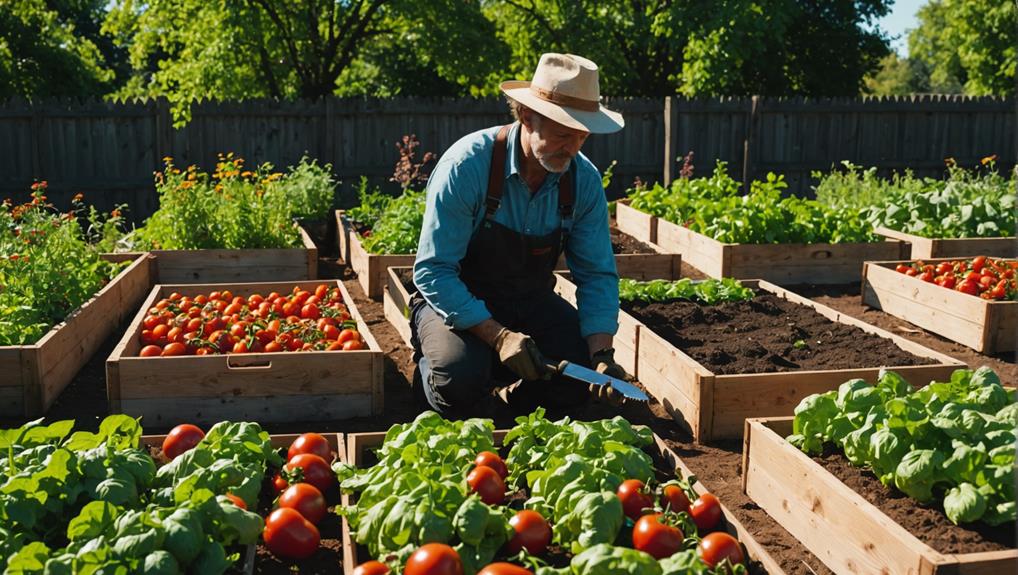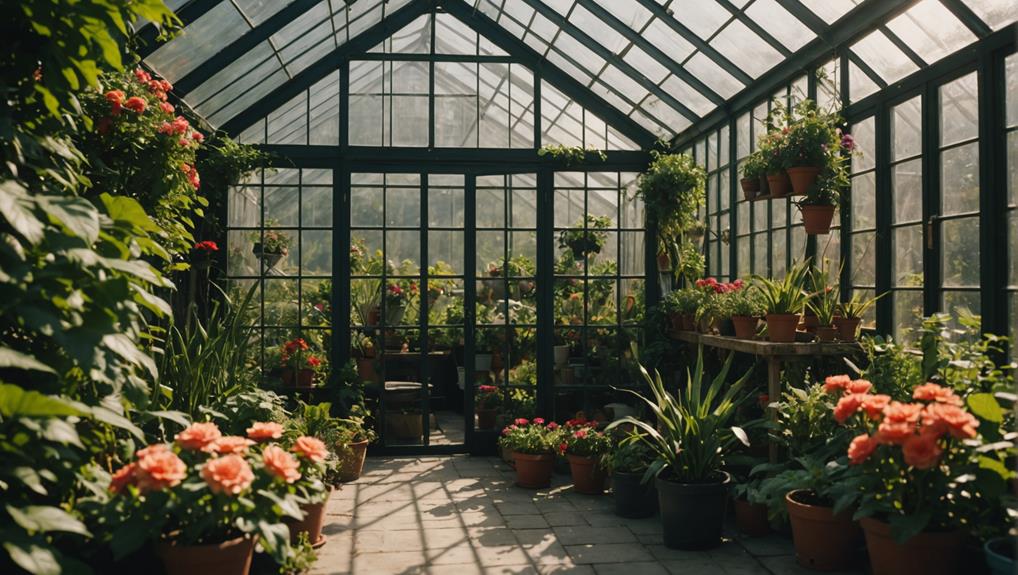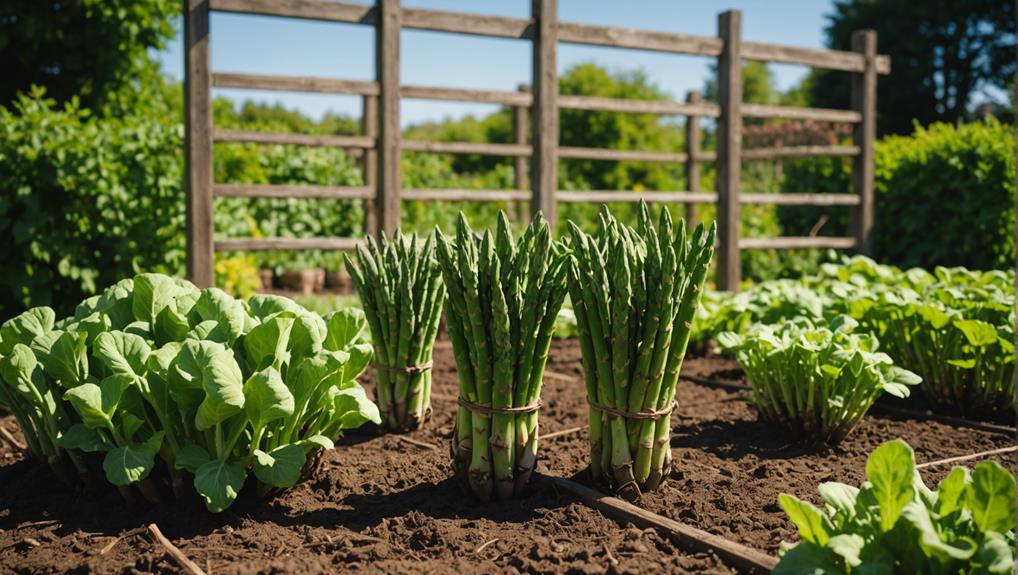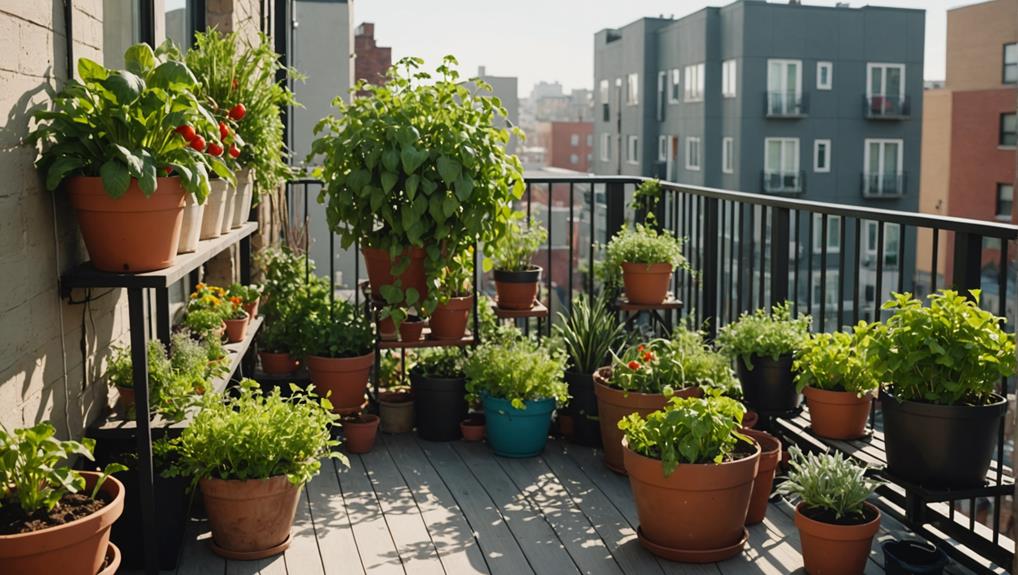As an Amazon Associate I earn from qualifying purchases.
Starting your prepper garden can seem intimidating, but choosing the right containers is a vital first step. You'll find that materials like glazed terracotta and grow bags offer unique benefits, but it's important to match the container size to your plants' needs. Ensuring proper drainage and soil quality, along with maximizing sunlight exposure, will set the foundation for a thriving garden. Have you ever considered vertical gardening to maximize your space? Tackling these basics will transform your approach to gardening and open up a world of possibilities. Curious about which vegetables thrive best in containers?
Choosing the Right Containers
When choosing containers for your prepper garden, you'll often find that the material, size, and drainage are all vital factors to take into account.
Different materials offer various benefits: glazed terracotta provides excellent moisture retention, plastic is durable and lightweight, and grow bags are breathable, ideal for root vegetables like potatoes.
Your container's size selection is significant too; larger plants such as tomatoes and cucumbers need at least 5-gallon containers, while herbs and smaller plants can thrive in 6 to 12-inch diameter pots.
Drainage is another important aspect. Always opt for containers with adequate drainage holes to prevent root rot, which can occur if water pools at the bottom.
Beyond functionality, consider the aesthetics of your garden. Grouping containers by design and plant type not only enhances visual appeal but also makes watering more efficient.
For the best results, avoid using yard soil. Instead, fill your containers with a high-quality potting mix, ideally composed of 50% compost, 25% coco coir, and 25% drainage materials.
This mix guarantees proper nutrient composition and reduces the risk of pests, setting up an ideal environment for growing plants.
Setting Up Your Containers
Start by placing your containers in a location that receives at least six hours of sunlight each day, making sure your plants get the energy they need to thrive.
Choose containers made from materials like glazed ceramic, plastic, or wood, and confirm they've adequate drainage holes to prevent root rot. Your container sizes should match the plants you intend to grow: larger 5-gallon pots for tomatoes and potatoes, and 6-12 inch containers for herbs.
Next, fill your containers with a high-quality, peat-free potting mix composed of 50% compost, 25% coco coir, and 25% drainage materials. This mix will provide ideal plant growth and moisture retention.
To create an efficient watering system and an aesthetically pleasing display, arrange your containers in groups.
Consider incorporating vertical gardening techniques. Use hanging baskets or vertical planters to maximize space, especially if you're growing climbing plants like beans and peas. These options not only save space but also add an attractive element to your garden setup.
Ideal Growing Conditions
To guarantee your container garden thrives, focus on providing at least 6 hours of direct sunlight daily and protecting your plants from wind.
Monitor soil moisture regularly, aiming for about 2 inches of water weekly, but adjust based on temperature and plant needs.
Don't forget to check for proper drainage to prevent root rot.
Sunlight Requirements
Ensuring your garden gets at least 6 hours of direct sunlight daily is essential for a bountiful harvest of fruits and vegetables. Most plants, especially those grown in containers, need ample sunlight to thrive.
Vegetables like tomatoes, peppers, and cucumbers flourish with abundant direct sunlight. Even though leafy greens and herbs can tolerate lower light conditions, they'll still perform best when placed in brighter spots.
If your containers are in shaded areas, expect fewer fruits and potentially leggy plants as they stretch toward available light. Regularly monitor and reposition your plants to maximize their exposure throughout the seasons.
Wind exposure is another factor to take into account. It can accelerate moisture loss in container plants, making it vital to use windbreaks or protective structures. This helps maintain the necessary moisture levels for healthy growth.
Watering Frequency
While sunlight is fundamental, watering your container plants correctly is equally important to guarantee they flourish.
Container plants typically need about 2 inches of water per week, but this can vary based on temperature and plant size. Monitoring soil moisture daily, especially in hot weather, is essential as containers can dry out quickly due to their limited soil volume.
To secure ideal growing conditions:
- Check soil moisture: Use the finger test; water your plants if the top inch of soil feels dry.
- Avoid overwatering risks: Confirm good drainage to prevent root drowning and nutrient leaching.
- Prevent underwatering: Look out for soil pulling away from the pot sides, which indicates plant stress.
Maintaining the right watering frequency is critical. Consistently moist, not waterlogged, potting soil is the goal.
Overwatering can lead to root rot, while underwatering stresses the plants. Adjust your watering schedule based on weather conditions and the specific needs of your container plants.
Wind Protection
Protecting your container plants from wind is vital to maintain their moisture levels and overall health. Wind can accelerate moisture loss, leaving your plants stressed and vulnerable. To combat this, consider placing your containers in sheltered locations or using windbreaks like fences or shrubs. This simple step can drastically improve your container gardening success.
Grouping your containers closely together helps reduce wind exposure and creates a microclimate that retains moisture and warmth. This setup not only minimizes moisture loss but also enhances overall growth conditions. Taller plants can serve as natural wind barriers for shorter, more delicate crops, providing additional wind protection.
Here's a table to illustrate some practical wind protection strategies:
| Strategy | Description |
|---|---|
| Sheltered Locations | Place containers near fences or walls |
| Grouping Containers | Cluster containers closely to create microclimate |
| Using Taller Plants | Taller plants shield shorter ones |
| Stable Containers | Use heavy pots to prevent tipping |
Regularly monitoring plant health is critical. Wind exposure can stress your plants, leading to reduced growth and increased vulnerability to pests and diseases. By implementing these wind protection techniques, you'll guarantee your container types are well-protected, promoting healthier and more resilient plants.
Best Vegetables for Containers
When choosing vegetables for containers, focus on dwarf varieties and the right container depths to guarantee success.
Tomatoes, cucumbers, and leafy greens each have specific pot requirements that maximize their yield and growth.
You'll also find that herbs and strawberries can thrive in smaller or hanging containers, making them perfect for limited spaces.
Dwarf Vegetable Varieties
Dwarf vegetable varieties like 'Paris Market' carrots and 'Tumbling Tom' tomatoes are perfect for container gardening due to their compact size and adaptability. These plants are specifically bred to thrive in small spaces, making them ideal for your pots on a patio or balcony. You'll find that their shorter growing seasons allow for quicker harvests, ensuring that you can enjoy fresh produce in no time.
Opting for dwarf varieties offers several benefits:
- Compact growth: These plants take up less space, allowing you to grow more in limited areas.
- Full-sized fruits: Despite their small stature, they still produce normal-sized vegetables.
- Diverse range: From cucumbers to strawberries, there's a variety of options to suit any preference.
For example, 'Spacemaster 80' cucumbers grow just 18 inches tall but still yield full-sized cucumbers, perfect for narrow containers. Similarly, 'Raspberry Yummy' strawberries provide the same delicious fruit as their larger counterparts but in a more manageable size for small spaces.
Optimal Container Depths
Ever wondered how deep your containers should be to guarantee your vegetables thrive? Understanding ideal container depths is vital for successful container gardening.
For deep-rooted vegetables like tomatoes and potatoes, you'll need a vegetable container that holds at least 5 gallons. This size is necessary for accommodating their extensive root systems.
Leafy greens, such as lettuce and spinach, require a minimum container depth of 12 inches. This depth supports their root systems and allows them to reach their full growth potential.
On the other hand, dwarf carrot varieties like Paris Market can grow well in containers as shallow as 8 inches, making them perfect for limited spaces.
When it comes to herbs, they're typically low-maintenance and need smaller containers ranging from 6 to 12 inches in depth. This range provides adequate space for their roots while keeping them easy to manage.
Climbing plants, such as cucumbers and pole beans, need containers that are at least 12 inches deep. This depth accommodates their extensive root systems and supports their vertical growth.
Choosing the right container depth for each type of plant guarantees your vegetable container garden flourishes, making your prepper gardening efforts both productive and efficient.
Vertical Gardening Options
Maximize your growing space with vertical gardening techniques that allow plants to thrive upwards rather than outwards. Vertical gardening is a fantastic method for making the most of small spaces, especially when you're dealing with container gardens. By using climbing plants like beans and peas, you can optimize your space while creating visual interest.
Consider these options to enhance your vertical gardening setup:
- DIY Vertical Planters: Use recycled materials to create cost-effective planters that support various plants.
- Hanging Baskets: Perfect for trailing plants, these can add layers of greenery at different heights, ideal for patios and balconies.
- Wall-Mounted Plant Fixture Clips: These support climbing plants without the need for drilling, making them easy to integrate into existing structures.
Vertical gardening also enhances air circulation around your potted plants, reducing the risk of diseases and pests.
By incorporating these techniques, you'll achieve better space optimization and healthier plants.
Whether you're a novice or a seasoned gardener, these vertical options can transform your small spaces into lush, productive gardens.
Essential Resources and Books
After setting up your vertical garden, you'll want to arm yourself with the right resources and books to guarantee your container garden thrives. As a beginner, diving into container gardening can be a lot easier with the help of some essential resources.
Start with 'The First-Time Gardener: Container Food Gardening' and 'Container Gardening Complete'. These books are packed with practical knowledge on growing food, plant care, and different container types. If you're interested in using fabric pots, 'Grow Bag Gardening' is your go-to book for understanding their benefits, like improved aeration and root health.
Online resources are invaluable. Gardening blogs and YouTube channels offer a plethora of tutorials and tips on container gardening techniques and ideal layout setups. Additionally, community gardening workshops can provide hands-on learning experiences, helping you connect with other gardeners and gain practical knowledge.
Check out free downloadable guides from reputable gardening websites. These guides can assist you in planning and executing a successful container garden layout tailored to your needs.
Here's a handy table to get you started:
| Resource Type | Resource Name/Type | Focus Area |
|---|---|---|
| Book | The First-Time Gardener | Beginner container gardening |
| Book | Container Gardening Complete | Plant care, growing food |
| Book | Grow Bag Gardening | Fabric pots, root health |
| Online Tutorial | Gardening Blogs/YouTube Channels | Container types, layout tips |
| Community Workshop | Local Gardening Workshops | Hands-on practical knowledge |
Equip yourself with these essential resources to make sure your container garden flourishes!
Conclusion
You've got this!
By choosing the right containers, setting them up properly, and ensuring ideal growing conditions, you'll create a thriving prepper garden.
Remember to contemplate vertical gardening to maximize space and select the best vegetables for your containers.
With proper research and the right resources, your garden will flourish.
Embrace the journey and enjoy the fruits (and veggies) of your labor.
Happy gardening!
As an Amazon Associate I earn from qualifying purchases.
